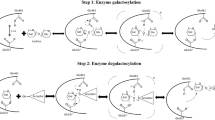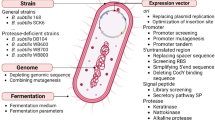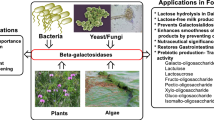Abstract
BGLII is a bacterial endoglucanase that hydrolyzes the β-1,3-glucan present in yeast cell walls, resulting in lysis of Saccharomyces cerevisiae. As a result of this property, BGLII is considered a potential tool for downstream processing and recovery of biotechnological products produced in yeast. Here we describe the improvement of the yeast lytic activity of BGLII, achieved by a directed evolution approach involving random mutagenesis and screening for variants with improved catalytic activity, combined with site-directed mutagenesis. A BGLII variant having three times the wild-type hydrolytic activity on laminarin was identified. The purified enzyme also exhibited higher lytic activity on yeast cells. Mutations causing the improvements are located very close to each other in the amino acid sequence, suggesting that the region should be considered as a target for further improvements of the glucanase activity. These results demonstrate the feasibility of molecular evolution methods for the improvement of the BGLII hydrolytic activity, and open a window for further improvement of this or other properties in glycosyl hydrolases in general.
Similar content being viewed by others
References
Manners, D. J., Masson, A. S., and Patterson, J. C. (1973) The structure of a β-(1 leads to 3)-d-glucan from yeast cell walls. Biochem. J. 135, 19–30.
Obata, T., Fujioka, K., Hara, S., and Namba, Y. (1977) The synergistic effect among β-1,3-glucanases from Oerskovia sp. CK on lysis of viable yeast cells. Agric. Biol. Chem. 41, 671–677.
Asenjo, J. A., Ventom, A. M., Huang, R.-B., and Andrews, B. A. (1993) Selective release of recombinant protein particles (VLPs) from yeast using a pure lytic glucanase enzyme. Biotechnology 11, 214–217.
Salazar, O., Molitor, J., Lienqueo, M. E., and Asenjo J. A. (2001) Overproduction, Purification and Characterization of β-1,3-glucanase type II in Escherichia coli. Protein Expr. Purif. 23, 219–225.
Parrado, P., Escuredo, P. R., Conejero-Lara, F., et al. (1996) Molecular characterization of a thermoactive β-1,3-glucanase from Oerskovia xanthineolytica. Biochem. Biophys. Acta 1296, 145–151.
Henrissat, H. (1998) Glycosidase families Biochem. Soc. Trans. 26, 153–156.
Bradford, M. M. (1976) A rapid and sensitive for the quantitation of microgram quantities of protein utilizing the principle of protein-dye binding. Anal. Biochem. 72, 248–254.
Laemmli, U. K. (1970) Cleavage of structural proteins during the assembly of the head of bacteriophage T4. Nature 227, 680–685.
Miller, G. L. (1959) Use of dinitrosalicylic acid reagent for determination of reducing sugar. Anal. Chem. 31, 426.
Higuchi, R. (1990) Recombinant PCR, in PCR Protocols. A Guide to Methods and Applications (Innis, M. A., Gelfand, D. H., Sninsky, J. J., and White, T. J. eds), Academic Press, San Diego, CA, pp. 177–183.
Planas, A. (2000) Bacterial β-1,3-1,4-glucanases: structure, function and protein engineering. Biochimica et Biophysica Acta 1543, 361–382.
Olivera, A. (2005). PhD thesis. Protein engineering of a lytic β-1,3-endoglucanase able of to permeabilize yeast cells. PhD thesis, University of Chile, Santiago, Chile.
Hahn, M., Pons, L., Planas, A., Querol, E., and Heinemann, U. (1995). Crystal structure of Bacillus licheniformis 1,3-1,4-beta-D-glucan 4-glucanohydrolase at 1.8 A resolution. FEBS Lett. 374, 221–224.
Malet, C. and Planas, A. (1997). Mechanisms of Bacillus 1,3-1,4-beta-D-glucan 4-glucanohydrolases: kinetics and pH studies with 4-methylumbelliferyl beta-D-glucan oligosaccharides. Biochemistry 36, 13,838–13,848.
Piotukh, K., Serra, V., Boris, R., and Planas, A. (1999) Protein-carbohydrate interactions defining substrate specificity in Bacillus 1,3-1,4β-d-glucan 4-glucanohydrolases as dissected by mutational analysis. Biochemistry. 38, 16,092–16,104.
Hahn, M., Keitel, T., and Heinemann, U. (1995) Crystal and molecular structure at 0.16-nm resolution of the hybrid bacillus endo-1,3-1,4-β-d-glucan 4-glucanohydrolase H(A16-M). Eur. J. Biochem. 232, 849–858.
Guex, N. and Peitsch, M. C. (1997) SWISS-MODEL and the Swiss-PdbViewer: An environment for comparative protein modeling. Electrophoresis 18, 2714–2723.
Author information
Authors and Affiliations
Corresponding author
Rights and permissions
About this article
Cite this article
Salazar, O., Basso, C., Barba, P. et al. Improvement of the lytic properties of a β-1,3-glucanase by directed evolution. Mol Biotechnol 33, 211–219 (2006). https://doi.org/10.1385/MB:33:3:211
Issue Date:
DOI: https://doi.org/10.1385/MB:33:3:211




